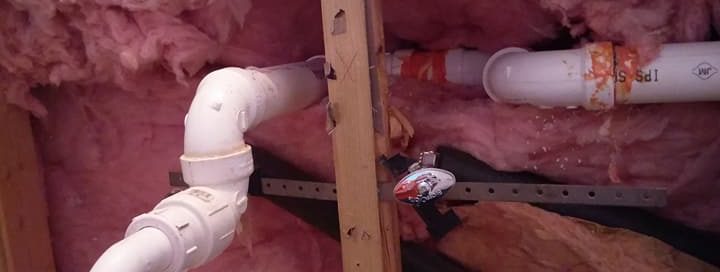Although “do-it-yourself” projects are all the craze now and can sometimes be effective, there are some jobs that should only be handled by a professional plumber.
In the plumbing world, DIY projects gone wrong can lead to leaks, frozen pipes, flooded homes, and worse. There are some tasks that the average homeowner can tackle. But it’s crucial to know what should be taken care of by contractors.
Trying to solve a plumbing problem yourself can end up being more expensive than hiring a professional, because you can accidentally make the issue worse and have to get emergency plumbing, which is more costly.
Here are some examples of when the homeowner took on a project themselves when they should have called a contractor. These outcomes resulted in more hassle and money for the homeowner. If they had just called a plumber in the first place, they might have saved themselves the trouble.
This person installed some pipes themselves, which wouldn’t drain and ended up leaking into the wall:

The following pictures show how a homeowner installed a toilet flange over two inches below the concrete floor.
However, we were able to jackhammer the floor, extend the pipe up, and install a toilet flange at the proper height. We did all this while still saving the linoleum floor.



It’s always better to be safe than sorry and just call a professional. However there are some tasks that are simple enough for you to take care of. Below, are a few examples of DIY projects that are typically safe to undertake.
Common toilet leaks
There may be some toilet leaks that are complicated and part of a larger problem, but most toilet leaks have common causes and have simple solutions.
One typical toilet leak is called the phantom flush and “happens when a toilet cuts on and off by itself, causing you to hear the toilet refill as if it was recently flushed.”
You can easily fix the problem. Just drain the tank and bowl then look at the flapper seat to see if it’s worn out. If it does seem old, go ahead and replace it, which usually solves the phantom flush.
Another issue that can be a DIY project with toilets is leaking seals. There are five seals that can possibly leak, and the solution is to drain and remove the tank then replace or tighten the seal. However, if this job is too physical or overwhelming, go ahead and call a plumber.
Outside spigot leak
The next plumbing problem it’s okay to handle yourself is leaky faucets. For example, one faucet that’s simple to fix is an outside spigot. If tightening the nut behind the handle doesn’t work, you might have to get a new packing gasket.
First, close the valve inside the house or main water valve to turn off the water. After buying a new packing gasket that matches the current brand, follow the steps provided by Today’s Homeowner to install a new washer:
- Turn the water off at the water meter using a cut-off key.
- Unscrew the packing nut beneath the handle of the facet.
- Grasp the faucet handle, and pull the valve stem out of the hose bibb.
- Remove the screw on the valve stem holding the faucet washer.
- Replace the washer with one of the same size and thickness.
- Push the valve stem back into the hose bibb housing.
- Tighten the packing nut on the hose bibb until snug.
- Use the cut-off key to turn the water back on at the meter.
- Turn the spigot back on to remove any air from the line.
- Check for leaks around the packing nut on the valve stem.
- Turn the faucet off and check the spigot for leaks.
However, before undertaking any recommended DIY plumbing projects, it’s important to make sure you have the right tools every homeowner should have, which include a water meter key, a heavy pipe wrench, a toilet auger, an adjustable wrench, and most importantly the contact information of a professional plumber to get help from.
At the end of the day, it’s better to hire a contractor than risk flooding your home or putting your family in danger. Reach out to us today with all of your plumbing needs and avoid spending more money on messed up DIY projects!

